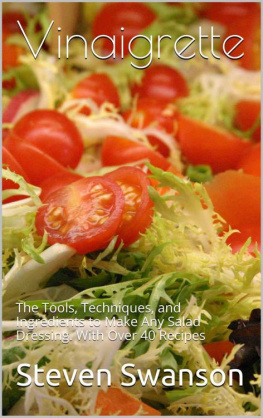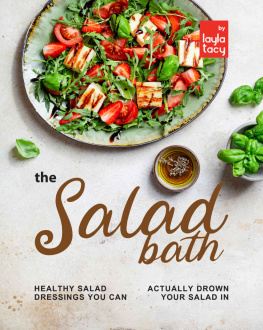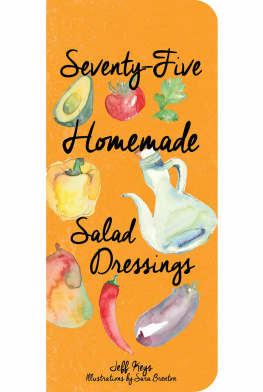Introduction
My own journey with homemade vinaigrettes began with thevenerable old task of Trying to Impress a Girl. Having tentatively gained theassent of a young lady far out of my league to join me for dinner in my tinyline cooks apartment, I endeavored to create home-cooked magic. We had stoppedby the market beforehand and picked up our supplies, including some freshgreens. Once home, I began to prep. I was confidently showing off my knifeskills when I realized I had nothing to dress my expertly chopped greens with.As if reading my mind, Jackie, my date who was busy peeling shrimp, asked,What kind of dressing do you have? Although this was years before culinaryschool and my first homemade vinaigrette, I fibbed, Oh, I make my own. Luckwould have it that I had some oil and vinegar around and a bottle to shake itin. The coyly astonished look I gotfrom Jackie as I tossed fresh greens in homemade dressing told me that my stockhad sharply risen. Jackies affections would be fleeting, but my affair withoil and vinegar would remain true.
Romance tactics aside, the first question that comes to mindwhen you see a book about making homemade vinaigrettes might be: Why should Ibother? My local supermarket has an entire aisle devoted to dozens of brands,types, and specialty flavors of salad dressing. The short answer: Most (if notall) of them are garbage; unfit for human consumption like so many of theproducts in a modern grocery store. The next time you are at your grocers pickup a random bottle and read the list of ingredients. If it contains more than,say, five ingredients its probably not food, but rather a food substitute.Sure, its technically edible, but just because you can doesnt mean youshould.
I conducted thisexperiment recently with a brand which will remain nameless here. First (andtherefore the most prominent) ingredient: Water. HmmmIn my long career as aprofessional cook and chef, never has water been the main ingredient in mydressing.
Second: Soybean oil.I could go on all day about this travesty, but I will (for now) spare you theire of my food snobbery. As we shall discuss in the following pages, there aremany wonderful oils available that make the base of delicious, healthy, andfortifying dressings. Soybean oil is not one of them. Why would a manufactureruse soy when there are so many better options? Its cheap as dirt, thats why.Soybeans are an enormous cash crop in the United States, second only to corn.Almost all of it is genetically modified to be resistant to chemical herbicide,which means the factory farms on which much of it is grown can dowse the plantswith large doses of Roundup without killing them. Yum.
The next ingredient on the list was vinegar. Just vinegar.Not wine vinegar or cider vinegarjust vinegar, which I suspect meansindustrial white distilled vinegar, which is utterly flavorless aside frombeing sour. Aside from being an effective cleaning solution it has no real usein the kitchen.
And then of course what American pseudo-food product wouldbe complete without a healthy dollop of, you guessed it, high-fructose cornsyrup. Apparently, all U.S. food manufacturers are contractually obligated toinclude HFCS in all their products.
It only gets worse from there. Xanthan gum, propylene glycol alginate, etc. I felt a brief shimmer of hope when (fardown the list) I found: Onions* and Red Bell Peppers*, but then concluded thatif you have to put an asterisk after your vegetables, theyre probably notreally vegetables. Perhaps they were at one time, before being consigned to thecorporate laboratory for re-education.
The good news is that although supermarket shelves arestacked high with chemical laden, insipid sludge for which the company spentmore money and thought on the package and label than the contents, we cantranscend these (sub)ordinary offerings and, armed with a little knowledge andsome basic tools, create cold sauces (which is really what salad dressings are)that are extra-ordinary and worthy of the greens we toss them in. A goodoreven greatvinaigrette is a cinch to make. A creamy-style, mayonnaise-baseddressing is only a little more complex.
My goal with this book is to inspire you to eat some thingswhich you may not have before. In this age of factory food, more of us areseeking out ingredients that popped out of the ground instead of a test tube.More and more farmers markets are cropping up all the time. No longer arestandard Iceberg or Romaine our only options for fresh greens. Every time Ithink Ive tried every salad green there is, local farmers prove me wrong. Andcold sauces arent just for greens. My French butchery instructor at Le CordonBleu liked his sauted calf brains with a drizzle of red wine vinaigrette. Ilike it on fresh fruit. To each his own, I guess.
Anyway, grab your whisk and Ill meet you in the kitchen.
Tools
The Basics
Shakers
Any container that can be sealed liquid-tight and given agood shake can be used to emulsify a vinaigrette. An oil bottle with a goodstopper works great, as does an empty wine bottle with a tightly fitting cork.I recommend sticking with glass, as plastic can impart a chemical flavor,especially if the dressing is going to be stored in the container for anylength of time.
Another good option is the old-school cocktail shaker. Notonly is it designed to be liquid-tight, but it also adds an element of fun andelegance to the process and presentation. Its also a kick to peruse thekitchen aisles of the local thrift stores for unusual shakers that can be hadfor next to nothing.
Whisks and Bowls
As your enjoyment in making cold sauces grows and yourrecipes become more complex, there will be times when you need tools with moreprecision and versatility than your trusty shaker. This is where whisking makesits appearance. You can put an egg yolk and a cup of oil into a container, butno amount of shaking will turn it into mayonnaise. For this we need finesse.Fortunately, whisks and mixing bowls are easy to find and inexpensive. If youdo any cooking at all, there is a good chance you already have them in yourkitchen. If not, I offer some suggestions; when shopping for mixing bowls gofor non-reactive materials like glass or earthenware. Metals like stainlesssteel or aluminum can leach their molecules into the ingredients, discoloringthe finished product. Nobody likes gray salad dressing. When choosing a whisk,do what the pros do: avoid gimmicks. A standard balloon whisk (so calledbecause its shaped like an old-timey hot air balloon) is the way to go. Itworks for just about everything; vinaigrettes, mayo, whipped cream, etc.
Zester
Citrus zest (which we will discuss later) is not to bewasted. There are many tools that may be used to harvest it, but the Microplane fine grater is the fastest, easiest, andproduces the best results. It can also be used to finely grate hard cheeses andspices like nutmeg. Your local kitchen store will almost certainly carry them.If you dont have such a shop near you, they are easily found online.
Knives
A set of good quality knives can turn what was once kitchendrudgery into pleasure worth looking forward to. And when preparing homemadefood is enjoyable, we are much more likely to do it instead of reaching for thefactory made stuff. As most professionals will tell you, a favorite knife,lovingly cared for and used often, begins to feel like part of you, like anextension of your hand.
The range of prices and materials of kitchen knives varieswildly. Sushi chefs are known to spend several thousand dollars for a hand-madeknife. Fortunately, we dont require such specialized tools. The first knifeone should buy is the chefs knife (sometimes called a cooks knife or Frenchknife). The quality of knife you choose will depend on your budget. I preferGerman made alloy knives which are middle of the road, price-wise. An 8 inchmodel runs about a hundred dollars. If this is out of your price range, fearnot. A good substitute made in countries with cheaper labor can be had forconsiderably less, and great bargains can be found in online store sales andcloseouts. Check out cutleryandmore.com.














